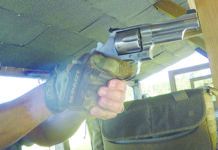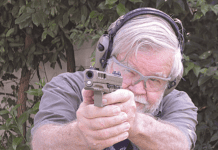Re “GI Pistols: Remington
Leads, But It Isn’t ‘Exactly’ a
GI Pistol,” October 2012
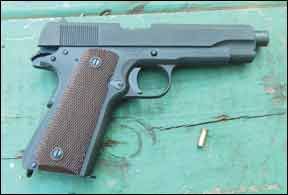
I enjoyed the article on the G.I. 1911 pistols; however, I just have to leave you these comments. You see, I am the owner of one of those destestable “West Hurley” Auto-Ordnance Pistols. I purchased the thing not knowing anything about the legendary Government Model 1911. I thought for $300 and some change I might learn something about them. After all, the dude with the shifty eyes wanting to sell it and standing next to one of the gun-show vendors could not possibly be looking for a sucker to rip off, now could he? Soon me and “Old Ugly” (the pistol) were punching out 10-rings with no problem. I noticed that the gun rattled a lot when I shook it. Also, some fool had taken a file to it and tried to smooth off some edges. Someone else had also replaced the original barrel with a Colt barrel. The old magazine looked as though it may have been at the D-Day invasion. I replaced the magazine with some Pro-Mag and Kimber types, put on a new slide stop, replaced the sights with Trijicon night sights, and held the whole thing together with JB Weld. Now the interesting part:
I liked the 1911 so much that I went out and traded my Beretta INOX 96 for a very expensive Springfield 1911A1. Wow, I thought if that old piece of junk can punch out the 10-rings, just think what I am going to be able to do now with the Springfield and the Crimson Trace laser sight. That old rattletrap West Hurley that looks like it was “beat on a rock in Afghanistan” outshoots anything I’ve put up against it. Don’t be so hard on those old Auto-Ord 1911s. They don’t deserve the bad reputation. —Bob
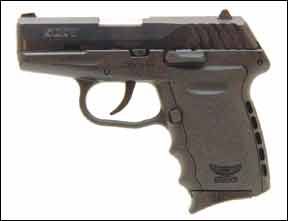
Re “Options for Concealed
Carry: Two Nines Vs. a Forty
Wheelgun,” July 2012
I have only recently read your review of the SCCY CPX-2. I have owned one for some time now. One issue that obviously got past you was the weakness of the magazine release, especially the spring. Very puny. I continue to deal with dropping magazines due to the spring strength and poor placement of the mag-release button. When I asked the company about a fix, all I got from SCCY was a smartass engineer who emailed me to “grab the bottom of the mag and pull. If it stays in, the catch and release are OK.” I sent two guns back with lots of problems, and they finally sent me a new gun. I’m about ready to use the one I have as a trotline weight. Sad. Other than that? It’s a decent gun and accurate as hell under 50 feet. Thanks for the article. At least somebody put the SCCY through its paces.
—Jim Kirk
Iola, Texas
Re “A Brace of Snubby
44 Specials: Taurus Takes on
Charter Arms,” July 2012
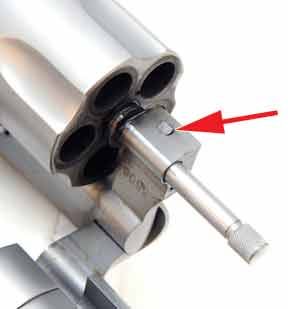
In separate articles, two different Taurus revolvers (M445B2UL in 44 Special and M405SS2 in 40 S&W) were reviewed. The article on the blued 44 Special revolver decried the poor lockup at the front crane provided by a mere .040-inch lockup. The SAAMI maximum average pressure (MAP) for the 44 Special is 15,500 psi. Presumably the same poor engagement capability existed on the stainless-steel revolver in 40 S&W (whose SAAMI MAP is 40,000 psi). Yet there is absolutely no mention of the flimsy forward lockup in connection with the much higher pressures encountered with the 40 S&W-chambered revolver. Your comment on the 44 Special Taurus was “the front ‘latch’ took only a slight push to overcome,” and that is a very significant detail worthy of mention. Why on earth would you comment on this shortcoming on a revolver chambered for a 15,500-psi cartridge and yet completely overlook it on a similar revolver chambered for a cartridge generating over 21⁄2 times as much pressure? Please explain. —Leo C. Petroski
Ray Ordorica wrote about the 44. I had no problem with the fit or strength of lockup on the 40-cal model I tested. So, I found no need to address it. —Roger Eckstine
Re “Three-Way
Gun-Protectant Test,”
September 2012
I have used Hoppe’s #9 for decades and never considered it as a rust preventer. When cleaning, I use Hoppe’s-soaked patches and a wetted bronze brush. Finish with dry patches, then a mop sprayed with G-66 gun spray for a preservative. I use hot soapy water with a mop for my blackpowder revolver, then dry patches and the oil mop. That’s it. I got sandbagged once when I used some unknowingly corrosive ammo in my Walther PPK. Caught it in time, bronze brushed it, and Hoppe’s got it clean. If you have a really fouled bore, try this. Clamp the gun in a padded vise upright, or remove the barrel if possible. Plug the bore and fill with Hoppe’s. Leave overnight. Drain, and everything should be clean! Save the Hoppe’s for re-use in this manner in a different bottle. Don’t mix the slightly used with the new. Same for Hoppe’s copper solvent. Those Foul-Out electric bore-cleaning kits work well, too. But the soak works just as well, I believe. I got the rubber bore plugs from them.
—Greg Fischer
Allentown, New Jersey
Please let me know where I can purchase the Smith & Wesson Premium Lubricant. I’ve checked with Smith & Wesson, Amazon, Brownells, and a lubricant website. Thank you,
—Kathy
It seems the S&W Premium Lubricant that was tested is no longer available anywhere. Brownells has it listed as discontinued. Any idea why, or where I might still be able to purchase it? It’s frustrating when Gun Tests evaluates products that are no longer available for purchase. Otherwise, love the magazine. —Mark

Reader Vic Ray was able to find some .5-ounces bottles of the Smith & Wesson Premium Lubricant at Grainger. To order, log on to Grainger.com, then search for item #4YNW6. While on the site, we also noticed a 1-ounce bottle was listed, item #4YNW3. Both were listed as clearance items with limited quantities available. I am making inquiries to find a chemically similar or identical product, but no luck so far. Will advise. —Todd Woodard
I must make a comment about your “Three-Way Gun-Protectant Test.” While Hoppe’s #9 is, indeed, a great solvent, it is neither an oil or a protectant. Hoppe’s Gun Oil is an oil. Thus, you are comparing two apples to an orange! I would have liked to see you toss in CLP for the third protectant. It does clean, lube, and protect pretty well. For AR-type rifles, an excellent lube and protectant can be made by mixing a half-quart of transmission fluid with a half-quart of synthetic 5W-20 motor oil. Spray it on the innards, it works great. Keep up the good work on the tests.
—Craig Wilcox
Weleetka, OK
We had very little space and time in which to test one new product. We put the new product against a proven one, never mind that it’s discontinued. In light of its stellar performance, perhaps it ought to be resurrected. Those who have read Elmer Keith know that he commonly used Hoppe’s No. 9 to preserve his many test guns. But we, and I’d bet most of our readers, didn’t know how well it would work to keep rust from forming. Of course it’s not an oil. Now we know that it’s far better than nothing for keeping rust at bay. —Ray Ordorica
Re “22 LR Takedowns:
Browning, Ruger, Marlin Go
Head to Head,” August 2012
I just wanted to point out that perhaps the reason the Marlin 39A had difficulty operating the lever in the evaluation by Ray Ordorica was because the takedown screw was too tight. Of course I don’t know if this was the case, but it might be something to examine. We own a Marlin 39A and have not experienced the sticky lever issue, but we have found that the tightness of the takedown screw is critical to proper operation. Thank you for your magazine. —Paul Roberts
Re “Dangerous-Game
357 Magnums: Cor-Bon, Grizzly
Clear Winners,” May 2012
I was very interested in your article on dangerous game ammo, as the question of whether or not my 357 Magnum revolvers (S&W Model 13, 4-inch barrel, and S&W Model 686, 2-inch barrel) should be considered for defense against bears in Alaska. Thanks to your article, either could be with the proper ammunition, although your report tended to favor the longer barrel to get the maximum performance out of the selected ammo.I noted that the preferred ammunition against bears in your tests were the FP Grizzly or JSP Cor-Bon, both of which have flat “points.” In this regard, the recent issue of Guns & Ammo published a “Cooperism” (page 36, October 2012), quoting Jeff Cooper in September 2002 as making the following observation:
“A ‘bear defense’ course was recently held and turned up a couple of interesting points. One is that sheer power will not do. If you are in real danger from a bear, he will be on top of you, and what you need is penetration and you must do that at contact distance. A 357 snubbie, using a very hard, sharp-pointed bullet would seem to be the answer.”
Several questions come to mind. In light of your tests, do you agree, and, if so, can you recommend a hard, sharp-pointed bullet? Would it make sense to carry a mixed load of several flat point bullets with the last two in the cylinder being sharp points? Would this give you stopping power as the bear charged and extra penetration at close quarters with the gun pressed up against the bear’s skull? Finally, would the greater ability to manipulate the 2-inch barrel in close quarters be an offset against the loss of performance at distance versus the 4-inch barrel. Thanks for considering these points. I look forward to every issue of Gun Tests.
—Jim Heimer
Houston, Texas
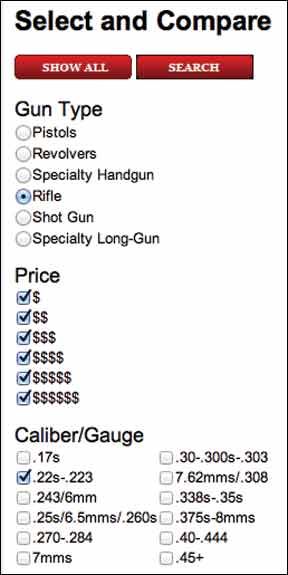
R. K. Campbell replies: “Sir, thanks for reading our magazine. Only you can answer the question of rapid manipulation of the two guns at short range. Do this by trying rapid-speed drills at the range. I’ll bet the answer becomes pretty clear pretty fast. As for a hard, sharp-pointed bullet — do not know of any, but the hard flat-nose bullets had ample penetration. They would certainly be my choice in the situation you describe. Hope I never find out.” Ray Ordorica adds: “The 357 Magnum must never be considered a ‘dangerous game’ cartridge. This is the sort of thing that can get people killed. When I and a group of sportsmen got handgun hunting legalized in Colorado, we made sure the regulations prohibited the use of such a small cartridge on elk. The last tracks I saw of an Alaskan bear measured 18 inches long and made a deep hole in the hard earth. I was armed with my double 470, and it felt like a BB gun against an animal that made such tracks. The only way a 357 will prevent an Alaskan bear’s doing damage to a human is if the human uses it on himself.”
Finding the Best AR-15
I recently started a subscription to your publication. I like it very much so far. I am looking at buying an AR-15 in the near future and am wondering if you did an evaluation on them at some point and which ones you rated an A overall or even an A-. I would like to buy one that is well made and user friendly, but do not necessarily want to pay the very top price for one. Which ones do you recommend? Thanks for your help.
—Morris Sherlin
Log in to Gun-Tests.com and search for AR-15s. The system will identify all the rifles we’ve tested over the years, most of which are still in production. Their grades will be listed along with the evaluations. Or you can use the “Compare Guns” select-and-compare feature on the website. —Todd Woodard






